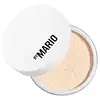Hourglass Cosmetics Vanish Airbrush Pressed Powder Versus Makeup by Mario Surrealskin Soft Blur Setting Powder
What's inside
What's inside
 Key Ingredients
Key Ingredients

 Benefits
Benefits

 Concerns
Concerns

 Ingredients Side-by-side
Ingredients Side-by-side

Mica
Cosmetic ColorantMagnesium Dna
Skin ConditioningPotassium PCA
HumectantSilicon
AbrasiveSodium Fluoride
Potassium Hydroxide
BufferingTin Oxide
AbrasiveSynthetic Fluorphlogopite
Silica
AbrasivePhenyl Trimethicone
Skin ConditioningBoron Nitride
AbsorbentCI 77220
Cosmetic ColorantMagnesium Myristate
Pentaerythrityl Tetraethylhexanoate
EmollientTriethoxycaprylylsilane
Caprylyl Glycol
EmollientDimethicone
EmollientEthylhexylglycerin
Skin ConditioningHydrogen Dimethicone
Aluminum Dimyristate
Emulsion StabilisingAllantoin
Skin ConditioningIsopropyl Titanium Triisostearate
EmollientIsostearic Acid
CleansingTocopherol
AntioxidantCI 77007
Cosmetic ColorantCI 77491
Cosmetic ColorantCI 77492
Cosmetic ColorantCI 77499
Cosmetic ColorantMica, Magnesium Dna, Potassium PCA, Silicon, Sodium Fluoride, Potassium Hydroxide, Tin Oxide, Synthetic Fluorphlogopite, Silica, Phenyl Trimethicone, Boron Nitride, CI 77220, Magnesium Myristate, Pentaerythrityl Tetraethylhexanoate, Triethoxycaprylylsilane, Caprylyl Glycol, Dimethicone, Ethylhexylglycerin, Hydrogen Dimethicone, Aluminum Dimyristate, Allantoin, Isopropyl Titanium Triisostearate, Isostearic Acid, Tocopherol, CI 77007, CI 77491, CI 77492, CI 77499
Synthetic Fluorphlogopite
Mica
Cosmetic ColorantSilica
AbrasiveLauroyl Lysine
Skin ConditioningKaolin
AbrasiveMagnesium Myristate
Zinc Stearate
Cosmetic ColorantDimethicone
EmollientSqualane
EmollientTetrahexyldecyl Ascorbate
AntioxidantPotassium Sorbate
PreservativeCaprylyl Glycol
Emollient1,2-Hexanediol
Skin ConditioningCI 77491
Cosmetic ColorantCI 77492
Cosmetic ColorantCI 77499
Cosmetic ColorantCI 77742
Cosmetic Colorant
 Reviews
Reviews

Ingredients Explained
These ingredients are found in both products.
Ingredients higher up in an ingredient list are typically present in a larger amount.
Caprylyl Glycol is a humectant and emollient, meaning it attracts and preserves moisture.
It is a common ingredient in many products, especially those designed to hydrate skin. The primary benefits are retaining moisture, skin softening, and promoting a healthy skin barrier.
Though Caprylyl Glycol is an alcohol derived from fatty acids, it is not the kind that can dry out skin.
This ingredient is also used as a preservative to extend the life of products. It has slight antimicrobial properties.
Learn more about Caprylyl GlycolCi 77491 is also hydrated iron III oxide. It's sole purpose is to give a red/pink hue to products.
Iron III oxides are classified as inorganic chemicals for coloring.
Synthetically created Ci 77491 is considered safer than those naturally found. This is because the synthetically created version may contain less impurities. Iron oxides are generally non-toxic and non-allergenic.
Learn more about CI 77491Ci 77492 is also hydrated iron III oxide. It's sole purpose is to give a yellow hue to products.
Iron III oxides are classified as inorganic chemicals for coloring.
Synthetically created Ci 77492 is considered safer than those naturally found. This is because the synthetically created version may contain less impurities. Iron oxides are generally non-toxic and non-allergenic.
Learn more about CI 77492Ci 77499 is also hydrated iron III oxide. It is created from mixing red and black iron oxides. This helps give shades of darkness to a product.
Iron III oxides are classified as inorganic chemicals for coloring.
Dimethicone is a type of synthetic silicone created from natural materials such as quartz.
What it does:
Dimethicone comes in different viscosities:
Depending on the viscosity, dimethicone has different properties.
Ingredients lists don't always show which type is used, so we recommend reaching out to the brand if you have questions about the viscosity.
This ingredient is unlikely to cause irritation because it does not get absorbed into skin. However, people with silicone allergies should be careful about using this ingredient.
Note: Dimethicone may contribute to pilling. This is because it is not oil or water soluble, so pilling may occur when layered with products. When mixed with heavy oils in a formula, the outcome is also quite greasy.
Learn more about DimethiconeWe don't have a description for Magnesium Myristate yet.
Mica is a naturally occurring mineral used to add shimmer and color in cosmetics. It can also help improve the texture of a product or give it an opaque, white/silver color.
Serecite is the name for very fine but ragged grains of mica.
This ingredient is often coated with metal oxides like titanium dioxide. Trace amounts of heavy metals may be found in mica, but these metals are not harmful in our personal products.
Mica has been used since prehistoric times throughout the world. Ancient Egyptian, Indian, Greek, Roman, Aztec, and Chinese civilizations have used mica.
Learn more about MicaSilica, also known as silicon dioxide, is a naturally occurring mineral. It is used as a fine, spherical, and porous powder in cosmetics.
Though it has exfoliant properties, the function of silica varies depending on the product.
The unique structure of silica enhances the spreadability and adds smoothness, making it a great texture enhancer.
It is also used as an active carrier, emulsifier, and mattifier due to its ability to absorb excess oil.
In some products, tiny microneedles called spicules are made from silica or hydrolyzed sponge. When you rub them in, they lightly polish away dead skin layers and enhance the penetration of active ingredients.
Learn more about SilicaSynthetic Fluorphlogopite is the synthethic version of mica. It consists of fluorine, aluminum and silicate.
Synthetic Fluorphlogopite is used to add volume to products.
It is considered non-irritating on the skin.
Learn more about Synthetic Fluorphlogopite